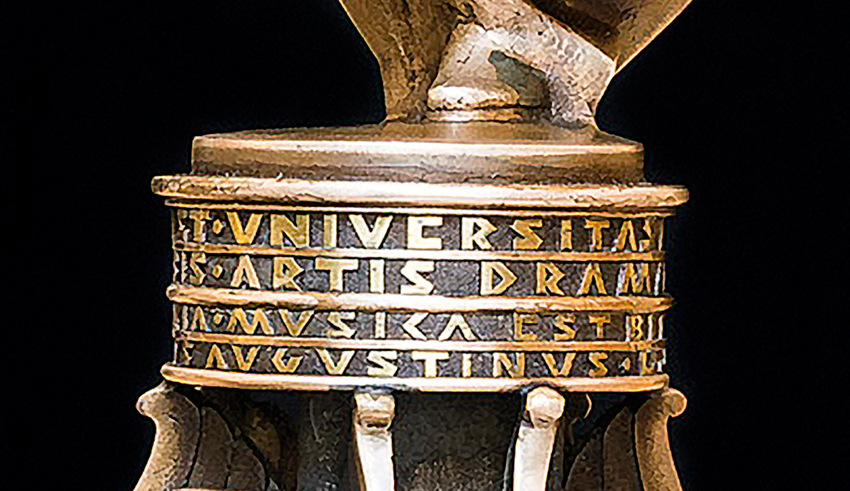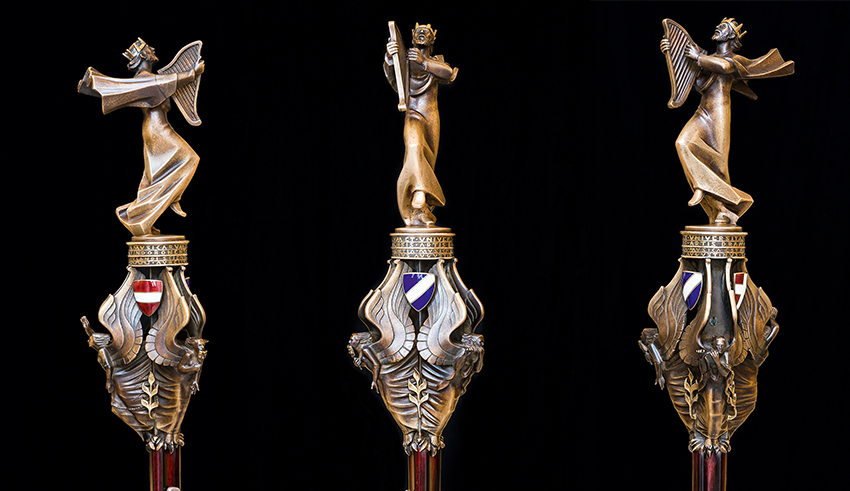A Conversation with Former Rector Gottfried Scholz
At their graduation ceremonies, mdw graduates swear to remain forever true to their alma mater with the words “Ich gelobe!” [I swear!]—whereupon they touch the sceptre of the mdw. Former mdw rector Gottfried Scholz speaks about the origins of this ceremonial sceptre in a conversation with Vice Rector Christian Meyer.

Christian Meyer (CM): Professor Scholz, at a ceremony a few months ago, you presented a bronze model of a dancing, singing, and lute-playing King David to Rector Ulrike Sych. This design represents all of the art forms taught at our university, and the figure that was made based on it now sits atop the sceptre of the mdw.
Gottfried Scholz (GS): This King David design is by the former rector of today’s Academy of Fine Arts Vienna, Professor Ferdinand Welz [1915–2008]. The whole story really begins back in 1982, when what was then the Academy of Music and Performing Arts Vienna launched its doctoral studies programme. Our offerings had to be solid from an academic standpoint, so in the beginning we involved full professors from the University of Vienna from fields such as psychology, German and Romance philology, and musicology as external evaluators. The first student to write her dissertation researched the psychological underpinnings of Alban Berg’s opera Wozzeck under my supervision, and it was at her graduation ceremony in April 1985 that the sceptre first saw use.
CM: Was there any opposition to the introduction of doctoral studies at the mdw?
GS: Faculty members at the University of Vienna were initially worried that we might hand out doctorates freely on the basis of simple oral exams, with neither dissertations nor any particular ceremony. That had indeed been the case at several German universities in the wake of the Movement of 1968, and also at the University of Florence, where the students briefly occupied the rectorate. But we were able to convince them that we intended to create something solid. Another thing we figured we had to do was grant our doctoral degrees in a dignified context, like they did at the University of Vienna. And for that, we needed a sceptre.

CM: Professor Welz had designed the edelweiss motif on the 1 Schilling coin and the golden hat-wearing woman on the 10 Schilling coin, as well as a commemorative coin to mark what would have been Max Reinhardt’s 100th birthday. I suppose it was those references plus his reputation as a sculptor that predestined him for the task at hand?
GS: The idea to do King David came from him. We went through the usual procedure of applying to the ministry to have his estimate approved, but the competent assistant department head felt unable to give his approval to such an unusual request. He told us: “I’m sending this upstairs!” After his section head had likewise refused to assume responsibility, I was obliged to present our request personally to Minister of Economy Herta Firnberg. So I briefed her on the King David concept, and we subsequently paid a visit to Professor Welz at his studio at the Academy. The preliminary model he created ultimately convinced the minister, which made it possible for us to commission the work. Federal government ministers actually made time for such things back then!
CM: The scrolls beneath the sculpture read UNIVERSITAS RERUM MUSICARUM ET ARTIS DRAMATICAE VINDOBONENSIS and MUSICA EST BENE MODULANDI SCIENTIA; the latter translates roughly as “Music is the science of proper composition”. The fact that the mdw is referred to here as a “university” is notable, seeing as the mdw continued on as an academy for over a decade thereafter and only became a university in 1998.
GS: I’d asked our Professor Friedrich Heller for a maxim that was concise and contained both music and performing arts; a few days later, he found this Latin quotation from De Musica by Augustine of Hippo. During the first few years, we would read the formal pronouncement in Latin, and the freshly minted graduates would respond “Spondeo ac polliceor”.
CM: Where did the model you’ve now presented come from?
GS: That was the model that Welz had completed to demonstrate the design, and after it had served its purpose, he turned it over to me. It spent the next 30 years decorating my desk, but ultimately, the place where this sculpture belongs is in the Rector’s Office at the university—and it gratifies me that Rector Ulrike Sych was pleased to accept it.

